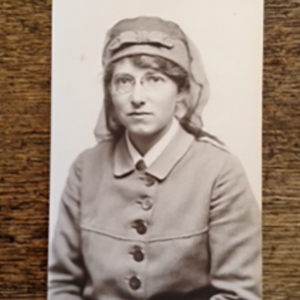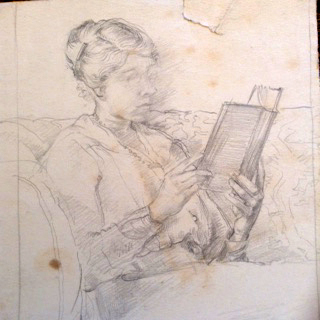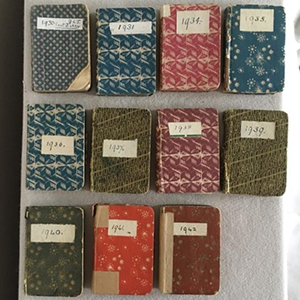(1) Muriel Rose. A Modern Crafts Legacy, edited by Jean Vacher. Chapter by Simon Olding’s Muriel Rose: An Introduction in the above exhibition catalogue.Craft study Centre.
(2) Muriel Rose. A Modern Crafts Legacy, edited by Jean Vacher. Kate Woodhead’s Foreword mentions Edith and Mary Flint as shop assistant's.
(3) Chelsea Child, An autobiography by Rose Gamble p 176. Her sisters are referred to as Lu and Dodie, so presumably Dodie and Lu were nicknames.
(4) Muriel Rose. A Modern Crafts Legacy, edited by Jean Vacher p 17 -4. Crafts study Centre.
(5) Maintaining the craft: British quilt-making 1900-1945 by Dorothy Osler. From Quilts 1700-2010. Hidden Histories, Untold Stories. Edited by Sue Prichard, 2010. V & A exhibition.
(6) The Women's League of Health and Beauty.
http://collections.vam.ac.uk/item/O94114/tea-cosy-rose-muriel
Quilts 1700-2010. Hidden Histories, Untold Stories edited by Sue Prichard.
Fabric. The Hidden History of the Material World. Victoria Finlay p 429
* Photos courtesey of the Craft Study Centre, Farnham.
** Photos courtesey of the Quilter's Guild, The National Quilt Museum, York
*** Sam Smith (1908-1983) is chiefly knows as a creator of beautifully crafted, fantastic painted sculptures. After art school Smith found it hard to make a living as a painter, and took on other work, and by 1935 he had become an odd-job man and gallery assistant for Muriel Rose. He began making small wooden objects for her and soon began making little toys for sale as gallery gifts. At this time he also did graphic design work, designing advertisements, greeting cards, cartoons, illustrations for books and as well as, for example, designing a catalogue for Fortnum’s & Masons. I wonder if he designed all the leaflets for The Little Gallery?
artuk.org/discover/artists/smith-sam-19081983#
The collection is now in the Manchester Metropolitan Archive.
Biographies
Margaret (Peggy) Turnbull (1892-1980)
Lived with her parents, doctor George Lindsay Turnbull (1859-1930) and her mother Ellen (1859-1944) and her older sister Ellen (1891-1980), known as Molly. The family lived at 76 Ladbrook Square, London. Both the doctor and his wife came from non-conformist families, his Scottish Presbyterians of an obscure sect and hers Unitarians. George Turnbull was known as a gentle kind man who played the violin and bought antiques. Ellen, who was a nurse before WW1, was known as rather sharp and upright, perhaps due to her nurses' training. Peggy did not marry and nothing is known of her education, nor where she learned book keeping. Before World War I became a volunteer nurse at the pioneering Endell St Army Hospital, Covent Garden, founded by Suffragist doctors Flora Murray and Louisa Garrett Anderson and staffed by women. (7)
The Turnbulls bought an old cottage at Crockham Hill, Froghole Lane, Edenbridge, Kent, as a holiday home, and enlarged it into an Arts and Crafts house, Harman's Orchard, moving there from London in 1926, when Peggy was 34. The gardener/driver lived in a cottage in the grounds and there was also a cook and a housemaid. From the diaries kept by Peggy's mother we learn of her interests. She played tennis on their own court, frequently went to folk dancing and with her mother attended the Women's League of Health and Beauty (8)
Peggy lived in the house all her life but around 1960 sold off the tennis court for a house to be built. Peggy played tennis and there is mention in the diaries of frequent folk dancing. On Peggy’s death the house was left to a nephew Richard, who lived there with his wife. On his death his widow sold the house which was then demolished.
When Peggy died in 1982 several items of The Little Gallery’s unsold stock were in her possession. Amongst the items were a quilted cot cover and tea cosy, made by Durham or South Welsh women quilters, now with the Quilter's Guild (6); an Eastern European small hand painted table top hat stand; A similar lamp base with two pleated shades (probably Cockerell Press); several small boxes, which would have been used as packaging or to sell; a selection of ephemera, including small four paged leaflets, labels, a very small Christmas Scrap Book and For Christmas Shopping Notes, all shown in this article. There were also eleven small diaries, some covered with Swedish or Italian papers, including five designed by Enid Marx. The first dated 1930 was the last diary kept by Peggy’s father Dr Turnbull. The rest from 1931-1942 were kept by his wife, Ellen Turnbull. These diaries are mundane in content but we get a hint of Peggy's life. We learn Peggy and her mother were sociable and hospitable. I have described any noteworthy entries in an additional listing.
I am pleased to say this small collection has found a home in the Manchester Metropolitan University Archive.
(7) Endell Street: The Trailblazing Women Who Ran World War One’s Most Remarkable Military Hospital by Wendy Moore.

Peggy in her Endell St uniform, dated 1915. Hopelessly short-sighted!

Portrait of Peggy by Molly, dated (clearly later) as 1912-14).

Diaries some with Enid Marx paper.
All images and text © meg-andrews.com 2021